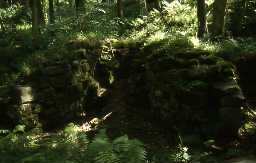Local History
Broomley and Stocksfield (Northumberland)
The parish of Broomley and Stocksfield lies in south Northumberland on the south bank of the River Tyne. It is divided in two by the Stocksfield Burn, which runs off the watershed near Minsteracres to the River Tyne at Stocksfield. Stocksfield is the largest settlement in the parish, stretching as it does from the banks of the River Tyne up the Stocksfield Burn. The name Broomley derives from the broom that grew there; and Stocksfield seems to mean `field by, or marked by, the posts.'
The earliest evidence we have for human activity in the parish comes from the Mesolithic period. This was a flint scraper discovered in the early 20th century, although there is some question about its possible origins in sand and gravel brought to Stocksfield from Eltringham, near Prudhoe. Further {flint scatters N10109} have been found around Broomley and are probably of Neolithic date. Unfortunately we have no evidence yet in this parish of where or how the people who made these tools lived.
Apart from a single Bronze Age knife reputed to have been found at Stocksfield, there is now a big gap with no evidence of any human activity until the Roman period. Then we have evidence of a farmstead, river crossing and roads, as well as a few coins and possibly even a villa. Dere Street would have been a busy route for transporting supplies for the Roman army between York and the Firth of Forth and it remained in use throughout the Roman period.
Like many parts of Northumberland there are no remains of the early medieval period known in Broomley and Stocksfield. It is only after the Norman Conquest that we can recognise remains of the past. Stocksfield and Broomley were only two of a number of medieval villages and hamlets in the parish, including Hindley and Old Ridley. But it is only at East Apperley that we can actually see the remains of a medieval village, with the roads, crofts and house sites surviving as earthworks and fields of ridge and furrow.
The medieval and post-medieval periods were troubled times in the Border regions of England and Scotland, with countless raids and skirmishes. Although Broomley and Stocksfield lies at quite a distance form the Border, there is at least one building, West Farmhouse, which is thought to incorporate the remains of a bastle. As the Border region became more peaceful in the 17th and 18th centuries, this building was extended and became a less defensive home. Other examples of houses built at this time include Apperley Farmhouse and Old Ridley Hall. Apart from agriculture, evidence of other post-medieval economic activities includes Wheelbirks Furnace, a 16th century bloomery site which has what may be the oldest blast furnace north of the River Tees. The 19th century saw the coming of the railway, with the opening of the Newcastle to Carlisle railway. By the later 20th century Stocksfield has largely developed as a commuter village for Tyneside.
The earliest evidence we have for human activity in the parish comes from the Mesolithic period. This was a flint scraper discovered in the early 20th century, although there is some question about its possible origins in sand and gravel brought to Stocksfield from Eltringham, near Prudhoe. Further {flint scatters N10109} have been found around Broomley and are probably of Neolithic date. Unfortunately we have no evidence yet in this parish of where or how the people who made these tools lived.
Apart from a single Bronze Age knife reputed to have been found at Stocksfield, there is now a big gap with no evidence of any human activity until the Roman period. Then we have evidence of a farmstead, river crossing and roads, as well as a few coins and possibly even a villa. Dere Street would have been a busy route for transporting supplies for the Roman army between York and the Firth of Forth and it remained in use throughout the Roman period.
Like many parts of Northumberland there are no remains of the early medieval period known in Broomley and Stocksfield. It is only after the Norman Conquest that we can recognise remains of the past. Stocksfield and Broomley were only two of a number of medieval villages and hamlets in the parish, including Hindley and Old Ridley. But it is only at East Apperley that we can actually see the remains of a medieval village, with the roads, crofts and house sites surviving as earthworks and fields of ridge and furrow.
The medieval and post-medieval periods were troubled times in the Border regions of England and Scotland, with countless raids and skirmishes. Although Broomley and Stocksfield lies at quite a distance form the Border, there is at least one building, West Farmhouse, which is thought to incorporate the remains of a bastle. As the Border region became more peaceful in the 17th and 18th centuries, this building was extended and became a less defensive home. Other examples of houses built at this time include Apperley Farmhouse and Old Ridley Hall. Apart from agriculture, evidence of other post-medieval economic activities includes Wheelbirks Furnace, a 16th century bloomery site which has what may be the oldest blast furnace north of the River Tees. The 19th century saw the coming of the railway, with the opening of the Newcastle to Carlisle railway. By the later 20th century Stocksfield has largely developed as a commuter village for Tyneside.
N13001
UNCERTAIN
Disclaimer -
Please note that this information has been compiled from a number of different sources. Durham County Council and Northumberland County Council can accept no responsibility for any inaccuracy contained therein. If you wish to use/copy any of the images, please ensure that you read the Copyright information provided.
